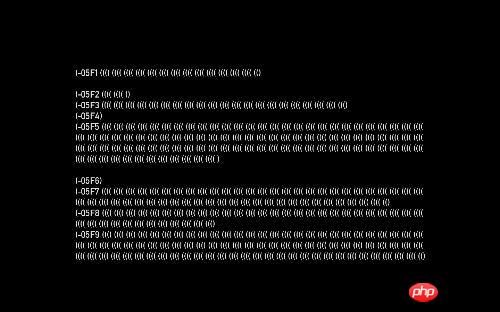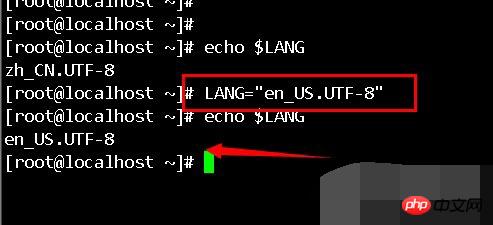 Operation and Maintenance
Operation and Maintenance
 Linux Operation and Maintenance
Linux Operation and Maintenance
 Summary of solutions to the problem of Chinese garbled characters under Linux
Summary of solutions to the problem of Chinese garbled characters under Linux
Summary of solutions to the problem of Chinese garbled characters under Linux
When you first start learning and using the Linux system, everyone will encounter a problem, that is, when the terminal input command is echoed, the Chinese characters are displayed as garbled characters. In fact, the problem of garbled characters is caused by the character set integrated into the system. Because the character set of the corresponding characters cannot be used correctly, the OS cannot recognize the text, resulting in garbled characters. If you need to operate files under Windows in Linux, you may often encounter file encoding conversion problems. The default file format in Windows is GBK (gb2312), while Linux is generally UTF-8. When the problem of Chinese garbled characters occurs, how should we solve it? What's the solution? The following content is to talk about the solution to the Chinese garbled problem under Linux.

Solution to Chinese garbled code problem under linux
1. Chinese garbled code problem under linux Solution
The files transferred from Windows to Linux are garbled, and we want to display Chinese in Linux. What should we do? We first test whether the Chinese in Linux can be normal. Display? Answer: yes. So the problem is more obvious. The copied files from Windows cannot be displayed, which means that the formats supported under Windows and Linux are different.
2. How about Chinese garbled characters in Linux? Solution
1) Check the current system language After logging in to the Linux system and opening the operation terminal, enter echo $LANG to check the current system language system language.
2) Check the installed language pack To check whether there is a Chinese language pack, you can enter the locale command in the terminal. If there is zh cn, it means that the Chinese language has been installed
3) What if there is no Chinese language? You can download and install the Chinese language package yum groupinstall chinese-support from the Internet (if you cannot download it from other computers, upload it)
3. Solve the problem of Chinese garbled characters in Linux
Modify the /root/.bash_profile file and add export.GB18030
For other users, the file must also be modified accordingly
putty can be displayed when using this method Chinese, but the desktop system is in English, and the Chinese display of all web pages is still garbled
4. Some cases of Chinese garbled files under Linux
In fact, the problem of garbled characters is caused by Caused by the character set integrated into the system. Because the character set of the corresponding characters cannot be used correctly, the OS cannot recognize the text, resulting in garbled characters. The solution is not difficult...
First of all, we need to know The language environment variables that control Linux OS are $LANG and $LC_ALL. To solve the problem of garbled characters, we only need to set the above two variables correctly.
5. Four steps to solve the problem of Linux system A problem with Chinese garbled characters occurred
CentOS system accessed g.cn and found Chinese garbled characters.
So I used the previous method: yum -y install fonts-chinese
After the CentOS system is installed, Chinese fonts still cannot be displayed. I use gedit to edit the source code, and the Chinese comments are also garbled.
Later, I finally found the following method to solve the problem, which requires two Chinese support packages:
fonts-chinese-3.02-12.el5.noarch.rpm
ftp://ftp.muug. mb.ca/mirror/centos/5.4/os/x86_64/CentOS/fonts-chinese-3.02-12.el5.noarch.rpm
fonts-ISO8859-2-75dpi-1.0-17.1.noarch.rpm
ftp://ftp.muug.mb.ca/mirror/centos/5.4/os/x86_64/CentOS/fonts-ISO8859-2-75dpi-1.0-17.1.noarch.rpm
One is Chinese font, One is the font display package.
6. Some experience in solving Oracle Chinese garbled characters under Linux
The reasons for garbled characters in Oracle database:
The operating system is consistent with the server, but the client is different from The server character set is inconsistent
The client is consistent with the server, but the operating system is inconsistent with the server
Solution:
Set the relevant character set to ensure that the operating system, client, and database server have characters for these three The sets are all the same.
Related questions and answers
1. Chinese garbled characters in the ubuntu folder
[Related recommendations]
1. php Chinese Free video tutorials on the Internet: "Brothers New Version Linux Video Tutorial"
2. PHP Chinese website related articles: "Linux Tutorial"
The above is the detailed content of Summary of solutions to the problem of Chinese garbled characters under Linux. For more information, please follow other related articles on the PHP Chinese website!

Hot AI Tools

Undresser.AI Undress
AI-powered app for creating realistic nude photos

AI Clothes Remover
Online AI tool for removing clothes from photos.

Undress AI Tool
Undress images for free

Clothoff.io
AI clothes remover

AI Hentai Generator
Generate AI Hentai for free.

Hot Article

Hot Tools

Notepad++7.3.1
Easy-to-use and free code editor

SublimeText3 Chinese version
Chinese version, very easy to use

Zend Studio 13.0.1
Powerful PHP integrated development environment

Dreamweaver CS6
Visual web development tools

SublimeText3 Mac version
God-level code editing software (SublimeText3)

Hot Topics
 1378
1378
 52
52
 How to start apache
Apr 13, 2025 pm 01:06 PM
How to start apache
Apr 13, 2025 pm 01:06 PM
The steps to start Apache are as follows: Install Apache (command: sudo apt-get install apache2 or download it from the official website) Start Apache (Linux: sudo systemctl start apache2; Windows: Right-click the "Apache2.4" service and select "Start") Check whether it has been started (Linux: sudo systemctl status apache2; Windows: Check the status of the "Apache2.4" service in the service manager) Enable boot automatically (optional, Linux: sudo systemctl
 What to do if the apache80 port is occupied
Apr 13, 2025 pm 01:24 PM
What to do if the apache80 port is occupied
Apr 13, 2025 pm 01:24 PM
When the Apache 80 port is occupied, the solution is as follows: find out the process that occupies the port and close it. Check the firewall settings to make sure Apache is not blocked. If the above method does not work, please reconfigure Apache to use a different port. Restart the Apache service.
 How to optimize the performance of debian readdir
Apr 13, 2025 am 08:48 AM
How to optimize the performance of debian readdir
Apr 13, 2025 am 08:48 AM
In Debian systems, readdir system calls are used to read directory contents. If its performance is not good, try the following optimization strategy: Simplify the number of directory files: Split large directories into multiple small directories as much as possible, reducing the number of items processed per readdir call. Enable directory content caching: build a cache mechanism, update the cache regularly or when directory content changes, and reduce frequent calls to readdir. Memory caches (such as Memcached or Redis) or local caches (such as files or databases) can be considered. Adopt efficient data structure: If you implement directory traversal by yourself, select more efficient data structures (such as hash tables instead of linear search) to store and access directory information
 How to restart the apache server
Apr 13, 2025 pm 01:12 PM
How to restart the apache server
Apr 13, 2025 pm 01:12 PM
To restart the Apache server, follow these steps: Linux/macOS: Run sudo systemctl restart apache2. Windows: Run net stop Apache2.4 and then net start Apache2.4. Run netstat -a | findstr 80 to check the server status.
 How to solve the problem that apache cannot be started
Apr 13, 2025 pm 01:21 PM
How to solve the problem that apache cannot be started
Apr 13, 2025 pm 01:21 PM
Apache cannot start because the following reasons may be: Configuration file syntax error. Conflict with other application ports. Permissions issue. Out of memory. Process deadlock. Daemon failure. SELinux permissions issues. Firewall problem. Software conflict.
 How to learn Debian syslog
Apr 13, 2025 am 11:51 AM
How to learn Debian syslog
Apr 13, 2025 am 11:51 AM
This guide will guide you to learn how to use Syslog in Debian systems. Syslog is a key service in Linux systems for logging system and application log messages. It helps administrators monitor and analyze system activity to quickly identify and resolve problems. 1. Basic knowledge of Syslog The core functions of Syslog include: centrally collecting and managing log messages; supporting multiple log output formats and target locations (such as files or networks); providing real-time log viewing and filtering functions. 2. Install and configure Syslog (using Rsyslog) The Debian system uses Rsyslog by default. You can install it with the following command: sudoaptupdatesud
 Does the internet run on Linux?
Apr 14, 2025 am 12:03 AM
Does the internet run on Linux?
Apr 14, 2025 am 12:03 AM
The Internet does not rely on a single operating system, but Linux plays an important role in it. Linux is widely used in servers and network devices and is popular for its stability, security and scalability.
 How to fix apache vulnerability
Apr 13, 2025 pm 12:54 PM
How to fix apache vulnerability
Apr 13, 2025 pm 12:54 PM
Steps to fix the Apache vulnerability include: 1. Determine the affected version; 2. Apply security updates; 3. Restart Apache; 4. Verify the fix; 5. Enable security features.




